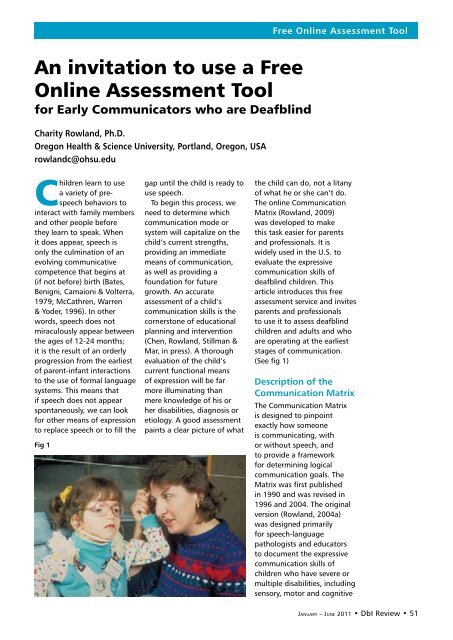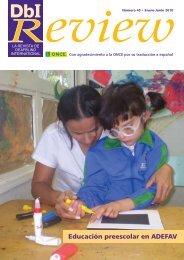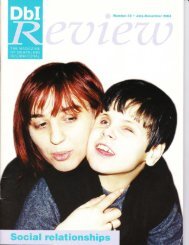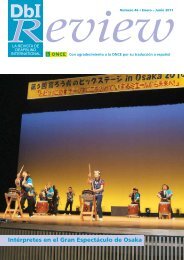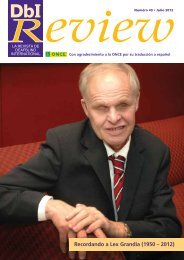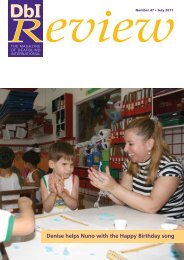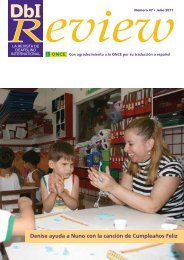Performers at Osaka's Big Stage - Deafblind International
Performers at Osaka's Big Stage - Deafblind International
Performers at Osaka's Big Stage - Deafblind International
You also want an ePaper? Increase the reach of your titles
YUMPU automatically turns print PDFs into web optimized ePapers that Google loves.
Free Online Assessment ToolAn invit<strong>at</strong>ion to use a FreeOnline Assessment Toolfor Early Communic<strong>at</strong>ors who are <strong>Deafblind</strong>Charity Rowland, Ph.D.Oregon Health & Science University, Portland, Oregon, USArowlandc@ohsu.eduChildren learn to usea variety of prespeechbehaviors tointeract with family membersand other people beforethey learn to speak. Whenit does appear, speech isonly the culmin<strong>at</strong>ion of anevolving communic<strong>at</strong>ivecompetence th<strong>at</strong> begins <strong>at</strong>(if not before) birth (B<strong>at</strong>es,Benigni, Camaioni & Volterra,1979; McC<strong>at</strong>hren, Warren& Yoder, 1996). In otherwords, speech does notmiraculously appear betweenthe ages of 12-24 months;it is the result of an orderlyprogression from the earliestof parent-infant interactionsto the use of formal languagesystems. This means th<strong>at</strong>if speech does not appearspontaneously, we can lookfor other means of expressionto replace speech or to fill theFig 1gap until the child is ready touse speech.To begin this process, weneed to determine whichcommunic<strong>at</strong>ion mode orsystem will capitalize on thechild’s current strengths,providing an immedi<strong>at</strong>emeans of communic<strong>at</strong>ion,as well as providing afound<strong>at</strong>ion for futuregrowth. An accur<strong>at</strong>eassessment of a child’scommunic<strong>at</strong>ion skills is thecornerstone of educ<strong>at</strong>ionalplanning and intervention(Chen, Rowland, Stillman &Mar, in press). A thoroughevalu<strong>at</strong>ion of the child’scurrent functional meansof expression will be farmore illumin<strong>at</strong>ing thanmere knowledge of his orher disabilities, diagnosis oretiology. A good assessmentpaints a clear picture of wh<strong>at</strong>the child can do, not a litanyof wh<strong>at</strong> he or she can’t do.The online Communic<strong>at</strong>ionM<strong>at</strong>rix (Rowland, 2009)was developed to makethis task easier for parentsand professionals. It iswidely used in the U.S. toevalu<strong>at</strong>e the expressivecommunic<strong>at</strong>ion skills ofdeafblind children. Thisarticle introduces this freeassessment service and invitesparents and professionalsto use it to assess deafblindchildren and adults and whoare oper<strong>at</strong>ing <strong>at</strong> the earlieststages of communic<strong>at</strong>ion.(See fig 1)Description of theCommunic<strong>at</strong>ion M<strong>at</strong>rixThe Communic<strong>at</strong>ion M<strong>at</strong>rixis designed to pinpointexactly how someoneis communic<strong>at</strong>ing, withor without speech, andto provide a frameworkfor determining logicalcommunic<strong>at</strong>ion goals. TheM<strong>at</strong>rix was first publishedin 1990 and was revised in1996 and 2004. The originalversion (Rowland, 2004a)was designed primarilyfor speech-languagep<strong>at</strong>hologists and educ<strong>at</strong>orsto document the expressivecommunic<strong>at</strong>ion skills ofchildren who have severe ormultiple disabilities, includingsensory, motor and cognitiveJan u a r y – Ju n e 2011 • DbI Review • 51


